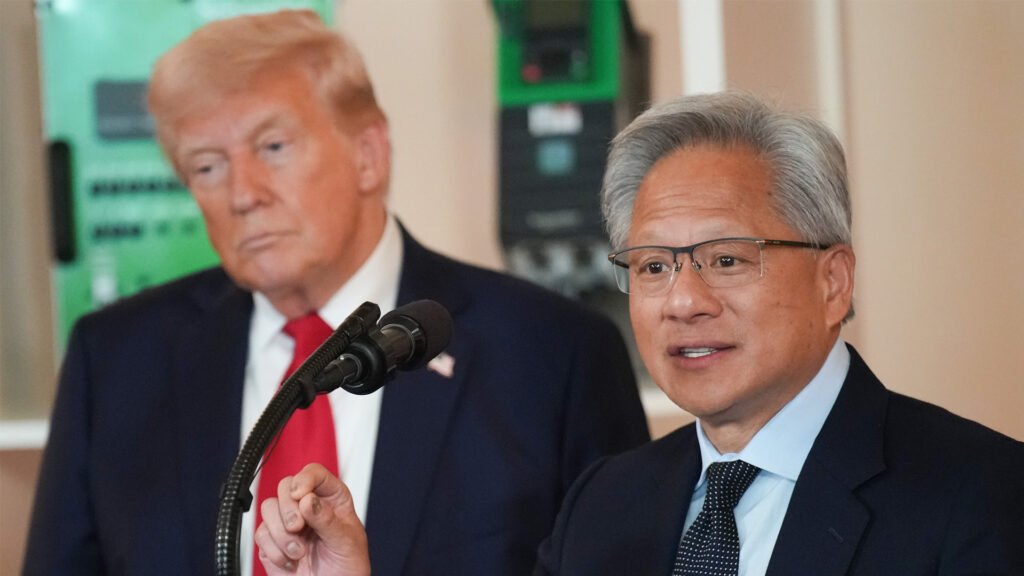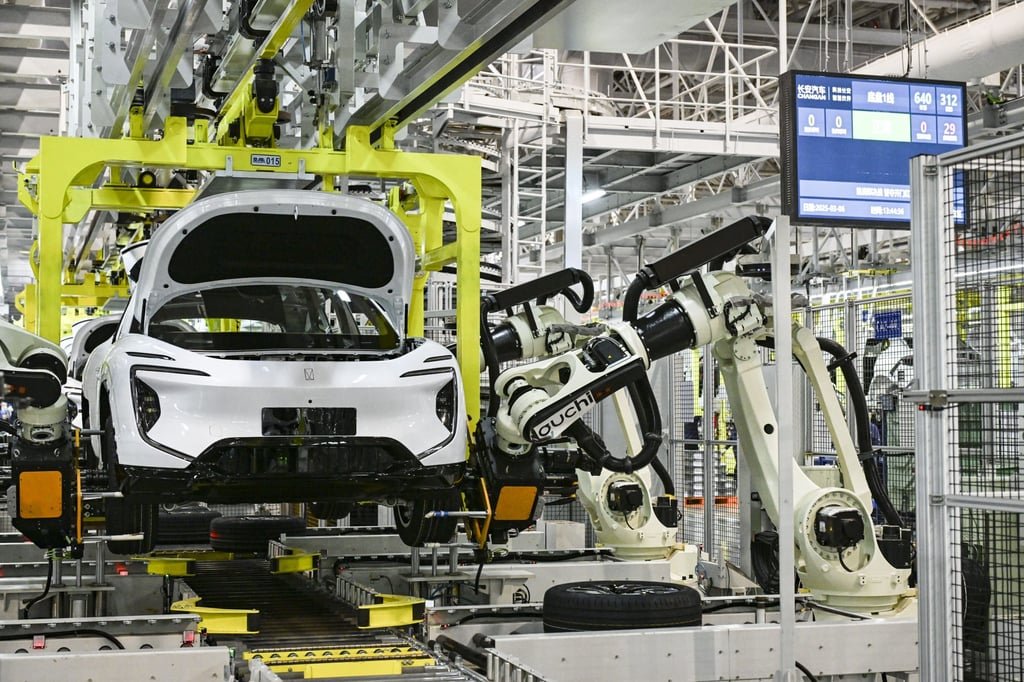With just one day left before the US-China tariff deadline on August 12, the future of the truce hangs in the balance. President Trump has yet to decide whether to extend the 90-day pause on reciprocal tariffs agreed in May, or to let rates on Chinese goods potentially climb back to over 80 percent. While both sides expressed optimism after late-July talks in Stockholm, progress has been slowed by disputes over rare earth exports, fentanyl, and the wider US trade deficit with China.
As businesses, investors, and global markets brace for impact, we examine whether the deadline will bring an extension of the tariff truce or a sharp hike in rates.
Start exploring
What’s on the line?
On August 12, reciprocal US tariffs on Chinese goods, as well as Chinese retaliatory tariffs on US goods, could return to 34 percent, up from the current 10 percent.
On April 2, 2025, Trump imposed “reciprocal” tariffs on over 90 countries, so named due to the US’s claim that the rates imposed were reciprocal (at a supposed “discounted” rate) to the tariffs and other non-tariff barriers that the target countries “charge” the US.
China was initially slapped with a 34 percent tariff, which later surged to 125 percent after China retaliated with matching tariffs on US imports. The US’s reciprocal tariff is imposed in addition to the 20 percent fentanyl tariff introduced in February and March of this year, meaning the on Chinese goods was upwards of 145 percent.
On May 12, following meetings between Chinese Vice Premier He Lifeng, US Secretary of the Treasury Scott Bessent, and US Trade Representative Ambassador Jamieson Greer in Geneva, the US and China agreed to a trade truce which saw commitments to cut the reciprocal tariff rates from 125 percent to just 10 percent for a period of 90 days – until August 12.
The existing 20 percent fentanyl tariff on Chinese goods remains in place, as well as the pre-existing Section 301 tariffs on certain goods. This means the minimum tariff rate on Chinese goods during the 90-day truce is around 55 percent.
Under the agreement, the two sides also committed to entirely canceling the higher reciprocal tariff rates imposed in succession from April 9, which culminated in the two-way 125 percent tariff.
This suggests that, should no extension be announced in the next day, the two-way tariff rates will return to 34 percent, not 125 percent. However, when adding the 20 percent fentanyl tariff, as well as the Section 301 tariffs and most-favored nation tariff, the final tariff rate on many Chinese goods will be upward of 80 percent.
Will the deadline be extended?
The expectation has generally been that the tariff truce will be extended for an additional 90 days to allow more time to reach a lasting trade deal.
Between July 27 and 30, Vice Premier He and Treasury Secretary Bessent met in Stockholm to discuss the ongoing trade disputes. Following the meetings, both sides expressed optimism that the deadline would be extended. In an interview with , Bessent stated that the meetings were “very far-reaching, robust, and very satisfactory.”
On July 27, an anonymous source told the that the two sides would extend the August 12 tariff deadline by a further 90 days.
In response to a media inquiry, China’s Ministry of Commerce (MOFCOM) that “the two sides will continue to push for a 90-day extension of the suspended 24 percent reciprocal tariffs on the US side and China’s countermeasures”, indicating an extension was on the table.
However, Bessent made clear that the decision to extend the deadline was “pending President Trump’s approval” and stated that China had “jumped the gun a little” in stating that an extension was going to happen. Trump later on Air Force One, “We’ll either approve it or not”.
However, in the weeks since the Stockholm meetings, Trump has not approved a deadline extension. Nonetheless, US officials have indicated that an extension is still on the table. Speaking to on August 3, Greer stated that the US was still working towards an extension, adding that he thought ongoing discussions on certain technical issues were “going in a positive direction”.
One day before the August 12 deadline, Trump has still not approved an extension. It is still possible he will do so at the eleventh hour and give his officials more time to reach a lasting agreement, but as his own staff has indicated, he will also be comfortable with allowing the tariffs to spike again.
Could tariffs go up again?
Despite the positive language following the Stockholm meetings, it is looking increasingly likely that the deadline will not be extended.
Trump’s officials have stated that Trump is happy to allow the tariffs to go up again, both to receive the tariff revenue and to use it as a bargaining chip.
In the CNBC interview, Bessent emphasized that Trump “is happy to do the deal, but is equally as happy […] just to have the tariff income”, and that this gives the US “a lot of negotiating flexibility”.
On August 6, Trump that a tariff hike on China in retaliation for purchases of US-sanctioned Russian oil “could happen”. That day, the US imposed an additional 25 percent tariff on India over its ties with Russia.
Speaking to on August 10, US Vice President JD Vance stated that Trump was “thinking about” imposing tariffs on China for purchases of Russian oil, but that he “hasn’t made any firm decisions”. He also emphasized that the US’s relationship with China goes beyond the Russia issue, and that the situation was therefore more complex than with India.
What’s delaying the decision?
Several issues are complicating the decision to extend the deadline, not to mention hindering a longer-term trade deal.
US and Chinese officials have met on several occasions to advance a possible trade deal since the May 12 agreement. However, beyond agreeing to uphold the commitments made in the Geneva meetings, little progress has been made.
Russia
As mentioned, Chinese purchases of Russian oil have come under the spotlight since the US imposed a 25 percent tariff on India, leading to questions on whether a similar tariff will be imposed on China.
Trump has become increasingly frustrated at the lack of a ceasefire deal between Ukraine and Russia – something he claimed would be achieved on his first day in office – and has threatened further sanctions in recent weeks. However, it is uncertain whether Trump will wish to further poison the well by punishing China ahead of a planned meeting between Trump and Putin next week.
Rare earth exports
Another key issue on the agenda is China’s rare earth exports. On April 4, China retaliated against the US’s reciprocal tariffs by imposing export controls on seven dual-use rare earth metals, requiring a license that takes 45 days to process. The rules apply globally, not just to the US.
Under the Geneva agreement, China agreed to drop non-tariff measures imposed since April 2. The US expected China to scrap or speed up the license process for US-bound goods, but such concessions were always unlikely, as the rules are embedded in Chinese law and apply to all countries.
On June 26, Trump that the US had signed a deal with China the previous day to facilitate the export of rare earths to the US. This was later reaffirmed by US Commerce Secretary Howard Lutnick, as well as MOFCOM, which that China will “approve the export applications of controlled items that comply with the conditions set out in the law” in exchange for the US lifting a “series of restrictive measures taken against China”. However, further details of the deal have not been released to the public, and it remains unclear how much the Chinese side has actually agreed to do to facilitate rare earth exports.
In the interview with CNBC on July 29, Bessent stated that the US was “pushing them to work on” perfecting the rare earths system, and that they had “made some very good progress on that”. In the interview with CBS, Greer also stated that the Stockholm talks “really focused on rare earth magnets and minerals”, suggesting that a conclusive deal was still under negotiation at the time.
If Trump feels that not enough progress has been made on this issue, he may seek to ratchet up pressure on China by allowing the tariffs to increase again.
Fentanyl, Iran, and the trade deficit
A range of additional disputes is also slowing progress. In February and March of this year, Trump imposed 20 percent tariffs on China in an effort to tackle the US’s domestic fentanyl epidemic in the US. Trump places the blame for the crisis on China, which he claims is exporting large quantities of fentanyl and precursor chemicals to the US. Beijing claims it has addressed the issue, but the US maintains that more needs to be done. Prior to the Stockholm meeting, people familiar with Beijing’s position told the that China was likely to push the US on “fentanyl” tariffs. However, neither side has provided any information on progress on this matter in the weeks since.
Another issue is Iran, specifically China’s purchases of Iranian oil. This appears to be a smaller sticking point for now. In the CNBC interview following the Stockholm meeting, Bessent noted that China is “a sovereign nation” with its own security needs and that the matter will depend on its internal policies. He also acknowledged the US has little leverage at present, beyond sanctioning Chinese “teapot” refineries and their owners.
A broader, longstanding concern is the US’s large trade deficit with China, one of Trump’s chief grievances. Bessent said the US hopes China’s upcoming five-year plan, which is set for discussion in the fall and implementation early next year, will shift economic policy from manufacturing toward consumption. This would “rebalance” trade by reducing exports and increasing imports. He added that the US has encouraged Beijing to make any such rebalancing measures public if they are included in the plan. However, it is highly unlikely that China will adjust its domestic macroeconomic policy in response to US pressure.
What should businesses do to prepare?
Businesses should plan for the strong possibility that US–China tariffs will rise again on August 12, potentially rebounding to a minimum of 84 percent. With only a day before the change takes effect, the immediate priority is to review supply chains, identify products most at risk, and calculate the likely cost impact. Companies should also revisit contracts with suppliers and customers to factor in sharply higher input costs.
Longer term, firms should diversify sourcing beyond China, explore alternative manufacturing hubs, and adjust pricing strategies to protect margins. Strengthening supply chain resilience and conducting regular scenario planning will be essential to managing the heightened uncertainty in US-China trade relations.
About Us
China Briefing is one of five regional Asia Briefing publications, supported by Dezan Shira & Associates. For a complimentary subscription to China Briefing’s content products, please click here.
Dezan Shira & Associates assists foreign investors into China and has done so since 1992 through offices in Beijing, Tianjin, Dalian, Qingdao, Shanghai, Hangzhou, Ningbo, Suzhou, Guangzhou, Haikou, Zhongshan, Shenzhen, and Hong Kong. We also have offices in Vietnam, Indonesia, Singapore, United States, Germany, Italy, India, and Dubai (UAE) and partner firms assisting foreign investors in The Philippines, Malaysia, Thailand, Bangladesh, and Australia. For assistance in China, please contact the firm at china@dezshira.com or visit our website at www.dezshira.com.








